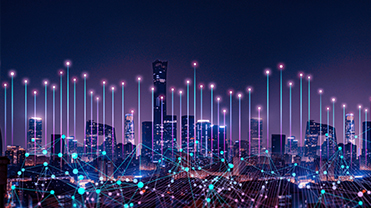Embracing artificial intelligence for
smarter, safer, and sustainable buildings
Artificial intelligence (AI), a rapidly advancing technology that focuses on making machines capable of intelligent behaviour, has been around for over 60 years and has played an important role in our lives since it started gaining momentum. With the ability to process vast amounts of data and learn from it, AI has the power to enhance human capabilities and revolutionise the way we live and work. From virtual personal assistants to self-driving cars, AI is already changing the way we interact with technology, and its impact is only expected to grow in the future. AI has huge potential to transform, and in fact is already transforming various industries, including healthcare, finance, transportation, and education. In recent years, AI has played an increasingly significant role in the evolution of smart buildings, enabling them to become more efficient, sustainable, and responsive to the needs of their users.
Recounting the (hi)story of building automation, and artificial intelligence
1960s : The world's first systems for reporting problems were implemented in commercial buildings, and the most famous of these was the Echo IV, a prototype of a home computer that could manage air conditioning, perform accounting tasks, and even create shopping lists.
1970s : Programmable Logic Controllers (PLCs) came onto the scene, becoming the first commercially available digital computers that control manufacturing processes.
1980s : Direct digital control's (DDC) user base exploded, displacing the older instrumentation and control systems. Ethernet became the universal standard for data transfers.
1990s : BACnet's open communication standard took the building automation industry by storm in 87, and three years later, KNX was introduced for commercial and domestic building automation.
BAS today utilizes a range of communication protocols to enable a connected ecosystem, including popular ones like – BACnet, Modbus, DALI, KNX.
Want more information about BACnet’s role in bridging the worlds of IT and BAS?

please share details
for download
1998s : The Internet played a big role during these years - WiFi made its debut and 'Internet of Things' became an official term.
2008 : The world discovered the benefits of cloud-based services, and BAS began moving to data centres, benefitting from better security and instant data availability.
2010 : Screens took over, and mobiles and tablets were increasingly used to control, manage, and innovate building equipment.
2016 : IoT usage grew in leaps and bounds, coming almost over 6 billion devices by this year.
2020 : Artificial Intelligence was fully incorporated into the smart building ecosystem. It began with simple automated tasks like turning lights on and off, and adjusting temperature; today, AI can rapidly perform complex tasks like detecting fires and predicting future energy consumption.
How AI can revolutionise buildings
Smart buildings have one purpose – to make the world better.
Better at conserving energy, which is crucial since buildings emit an enormous amount of CO2, going as high as 37% in 2022.
Better at creating optimal environments to increase occupant comfort, leading to increased productivity and well-being.
The key to becoming better is data, which is aggregated every second from all devices operating within smart buildings, from the sensors to the controllers to the heating, ventilation, and air conditioning (HVAC) or any other systems and sub-systems. Sifting through these massive amounts of data is a daunting task, and this is where AI steps in, with its ability to process mass volumes of information in a fraction of seconds for actionable insights.
As AI technology has advanced over the years, so too has its application in smart buildings. For example, machine learning algorithms can now analyse data from sensors to optimise energy usage, reduce waste, and improve occupant comfort. These algorithms can predict energy usage patterns to identify areas of inefficiency and suggest solutions for improvement. They can also predict occupancy patterns to ensure that lighting, HVAC, and other systems are only used when needed, optimising energy usage and reducing costs.
By far the most important application of AI in smart buildings is in predictive maintenance. By analysing data from sensors and other IoT devices, AI algorithms can identify potential maintenance issues before they become major problems. This allows building owners and operators to take corrective action before an issue arises, reducing downtime, minimising repair costs, and improving the overall reliability of the building.
AI is also transforming the way we think about building security. Facial recognition technology, for example, can be used to identify and track individuals as they move through the building, ensuring that only authorised personnel have access to sensitive areas. AI-powered surveillance systems can also analyse video feeds in real-time, alerting security personnel to any unusual activity or potential threats.
Finally, AI is being used to improve the comfort and well-being of building occupants. Smart building systems can use data from sensors to adjust lighting and temperature settings based on the preferences of individual occupants. AI algorithms can also be used to predict and prevent issues related to indoor air quality, such as high levels of CO2 or other pollutants.
While AI has already made significant contributions to the evolution of smart buildings, there is still much potential for further innovation. As AI technology continues to advance, we can expect to see even more innovative AI use cases emerge in the years ahead. The future of smart buildings is bright, and AI will play a central role in its continued evolution.
At Softdel, we are committed to staying at the forefront of AI innovation in smart buildings. Our team of experts is constantly developing new solutions that leverage AI to optimise building performance, enhance occupant comfort, and improve building security. See how Softdel supports buildings of the future.





